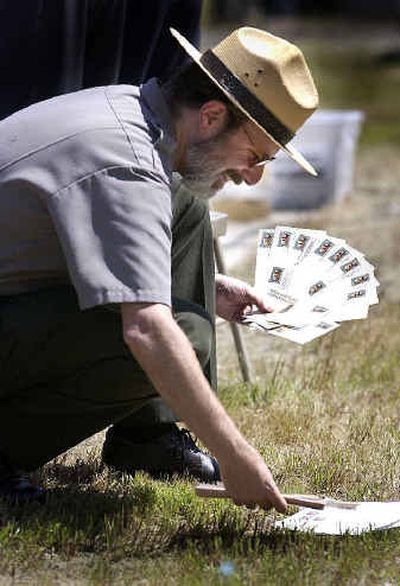Stamps unveiled in Idaho

OROFINO, Idaho — The Pink House Hole, a rare flat spot along the banks of the Clearwater River, was the site of an uncommon gathering Friday morning to see the faces of Capt. Meriwether Lewis and Capt. William Clark — peering across the gulf of two centuries — once more gazing sternly at an assembled crowd of whites and Nez Perce Indians.
As blue fabric was whisked away, portraits of Lewis and of Clark were revealed to some 200 people who came to attend a “First Day of Issue” ceremony in which the U.S. Postal Service unveiled stamps to commemorate the bicentennial of the Corps of Discovery’s epic journey across what is now the American West.
The new stamps, there are three, made a simultaneous debut at 11 places along the corps’s route on Friday, including this sunny beach and fishing spot just downstream from the city of Orofino. Pink House Hole is so named because there once was a house near here, and it once was painted pink.
The sudden wide spot along two-lane U.S. Highway 12 would seem an unlikely place for such an event, which drew dignitaries from as far as Washington, D.C.
Orofino Postmaster Ben Carpenter, ready to retire after 30 years, admitted to a sleepless night as he prepared to make opening remarks in front of the assembled bigwigs. And he was honored, he said, to find himself autographing stamp booklets for the first time in his life.
“Orofino is not the stamp-collecting capital of the world,” mused Dick Thomas, a philatelist from Boise. “But it’s a nice site. Look. Here we are on the Clearwater. You can almost see Lewis and Clark going down.”
Orofino was chosen as one of the debut sites because in this place, or very close to it, the cold, wet and desperately hungry band of explorers was warmly greeted — and fed — by a village of Nez Perce led by Twisted Hair. And, with gravity on their side for the first time in the journey, the corps constructed five dugout canoes — again with the assistance of the Nez Perce — and paddled down the Clearwater, the Snake and the Columbia all the way to the Pacific Ocean.
It was a sense of history more than philately that drew many to the Pink House Hole on Friday. History, and the novelty of being present at a rare event of national import. Under a warm sun, people stood in patient lines to purchase stamps and special booklets, have them canceled by area postmasters and then autographed by invited guests from the Postal Service, state and local historical societies and the vice-chairman of the Nez Perce Tribe.
Some families flocked to picnic tables and began writing postcards bearing the new stamps to send to friends and relatives.
“I love all the people here. This is such a tickle,” Thomas said. “I know they’re not stamp collectors but, philatelically speaking, this is rare. The last First Day of Issue in Idaho was 32 years ago.”
Though Thomas called stamp collecting the nation’s most popular hobby, it is not big among the Nez Perce, some tribal members said. And two tribal members wondered what would be in store as they drove to the ceremony.
“Do you think they’ll ask you to lick the first stamp?” one asked.
“If they do, we can put it on a letter and send it to President Bush,” the other said.
If so, it would arrive across the continent in a matter of days, and cost only 37 cents, which would seem a marvel and a bargain to people from 200 years ago said Joyce Carrier of Washington, D.C., Manager of Public Affairs for the Postal Service.
“Thomas Jefferson was interested in what the explorers found and even suggested they find letter carriers among traders or native peoples” along the way, Carrier said. The nation’s third president wanted copies of the Corps of Discovery’s journals, notes and specimens of plant and animal life.
This at a time “when the recipient paid the postage and the rate was based on both weight and the difficulty of conveyance. It was probably a lot more than the 37 cents we pay today,” Carrier said.
His tightly woven braids coming nearly to his lean waist, Levi Holt, a Nez Perce tribal council member leaned against a boulder as he watched the scene unfold.
“It’s a beautiful day today,” he said as the Clearwater swooshed past in spring flood, cleaving the steep valley still showing the green of new plant life. “The day Lewis and Clark were found by the Nez Perce, floundering and lost, was also a beautiful day. In the spirit of friendship this is a good day to look back.”
But a look back shows a journey of discovery can lead to different places.
“For non-Indians it’s been glory and success and bright future,” Holt said. “For Indians along the trail, from the Missouri to the Columbia, it’s been detriment and pain and anguish. But with God’s blessing, I’m still here. The Nez Perce are still here. I hope we are still here in 1,000 years.”
Tribal vice-chairman Allen Slickpoo Jr. said the Nez Perce have made a different voyage of discovery as they have meshed their identity into the American nation and have worked to keep a grip on their heritage, their history and their religion.
Even though the Nez Perce have never left, “we’ve come a long way,” he said.